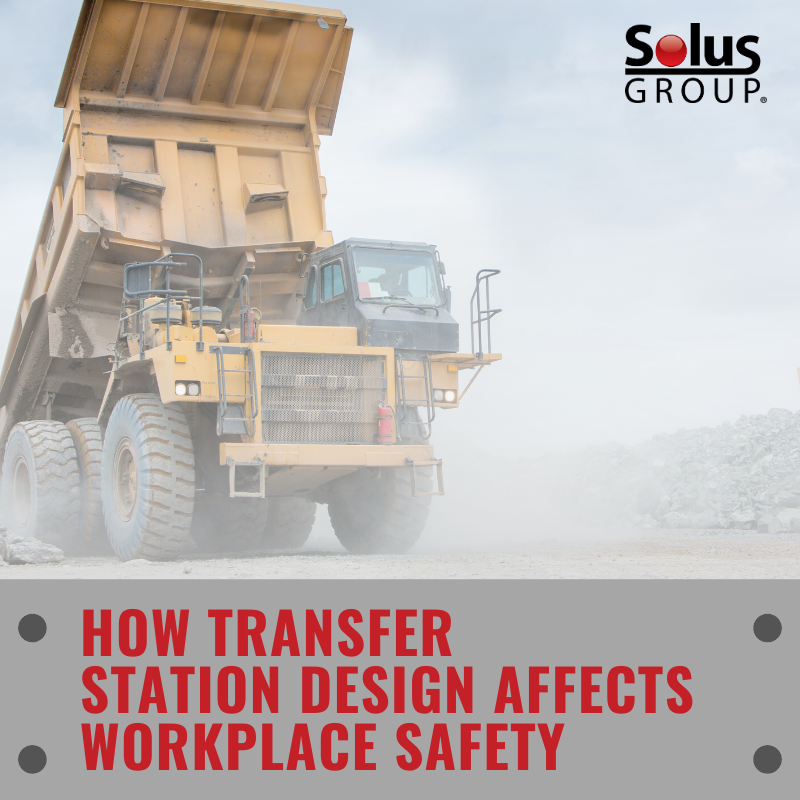We use cookies to make your experience better. To comply with the new e-Privacy directive, we need to ask for your consent to set the cookies. Learn more.
How Transfer Station Design Affects Workplace Safety
Transfer station design isn’t just about controlling operational costs. The placement, layout, and infrastructure in a transfer station all contribute strongly to the safety of the people who work there. In other words, the original design of the facility is integral to the success of any health and safety program, even one enacted years down the line. 
For instance, take the oldest design error in the industry: insufficient capacity. Waste systems tend to use transfer stations for decades at a time. A facility that works great for 100 tons of daily waste will have problems if, two years later, haulers start delivering 300 tons per day.
Stretching a facility past capacity can create unsafe situations. More waste means more exposure to waste, including needles and other sharps. Even worse, a faster working pace breeds carelessness among even the most conscientious staff members.
In addition to planning for future capacity and waste composition, then, here are a few transfer station design tips that will create a safer workplace for years to come:
- Place PPE lockers in prominent locations that workers can’t help but notice before they enter work areas. The National Waste & Recycling Association (NWRA) lists six pieces of essential personal protective equipment for workers in transfer stations: class-2 high-visibility clothes, hard hats, shoes with protected toes, safety glasses, puncture-resistant gloves, and hearing protection.
But this protective clothing only works when employees remember to use it. That’s why it’s a good idea to make PPE lockers highly visible and located in staff areas, not the work floor.
- A one-way loop is the safest traffic travel plan. Waste-collecting vehicles and transfer trailers are dangerous enough without having to drive backwards, with limited visibility. Traffic lanes designed for one-way travel make it much easier for drivers to see where they’re going and minimize confusion, reducing the risk of accidents.
- Create different traffic lanes for large dump trucks and smaller vehicles. Similarly, separating large-scale waste collecting vehicles from smaller self-haulers can reduce confusion and the risk of injury. If possible, route self-hauling cars or trucks to an area entirely separate from traffic loops designed for municipal vehicles.
- Wherever possible, separate vehicle traffic lanes from pedestrian areas with physical barriers. Appropriate signage and road paint are essential for a safe transfer station, but nothing beats a good physical barrier. Keep vehicles from pedestrian pathways with steel Structural Bollards or Barrier Rails to reduce the risk of accidents with potentially deadly outcomes.
- Provide material handling equipment that discourages manual lifting and limits contact with waste. Solid waste streams contain objects that can injure workers on contact, from used needles to explosive lithium-ion battery packs. In addition, manual handling of bins and totes can lead to strains, sprains, muscle tears, and other musculoskeletal disorders.
Any piece of material handling equipment that employees can use to avoid contact with waste is worth consideration. Facilities that rely on bins and dumpsters, for instance, should provide hydraulic Bin Dumpers to reduce the risk of musculoskeletal injury. These devices can be particularly effective for self-haulers, who would otherwise manually empty waste bins at the self-drop location.
Arguably, the most important safety infrastructure in a transfer station isn’t part of the facility’s design. Ongoing safety training not only gives employees the behavioral tools they need to stay safe on the job, it strengthens and supports the role of workplace safety in the company culture.
Training resources are available. The NWRA offers multiple safety initiatives free of charge. Find those resources here. Or look through the Solid Waste Association of North America’s (SWANA) Safety Matters site, available here, for more training events and resources.
With robust safety training and some of the transfer station design tips listed above, every post-collection facility can keep its workers comfortable and injury-free for the long haul.
References:Bukojemsky, Stefan. “TRANSFER: Transfer Station Design Tips.” Waste360. Informa Markets, 1 Jan. 2003. Web. 27 Dec. 2019.
McMullen, Cheryl. “How to Keep Employees Safe at Post-Collections Facilities.” Waste360. Informa Markets, 11 Apr. 2017. Web. 27 Dec. 2019.
Redling, Adam. “What to know about transfer station management.” WasteTodayMagazine. GIE Media, Inc. 25 Jun. 2019. Web. 27 Dec. 2019.
“Transfer Station Safety Issues I.” WasteAdvantageMag. Waste Advantage Magazine, 15 Aug. 2014. Web. 27 Dec. 2019.
